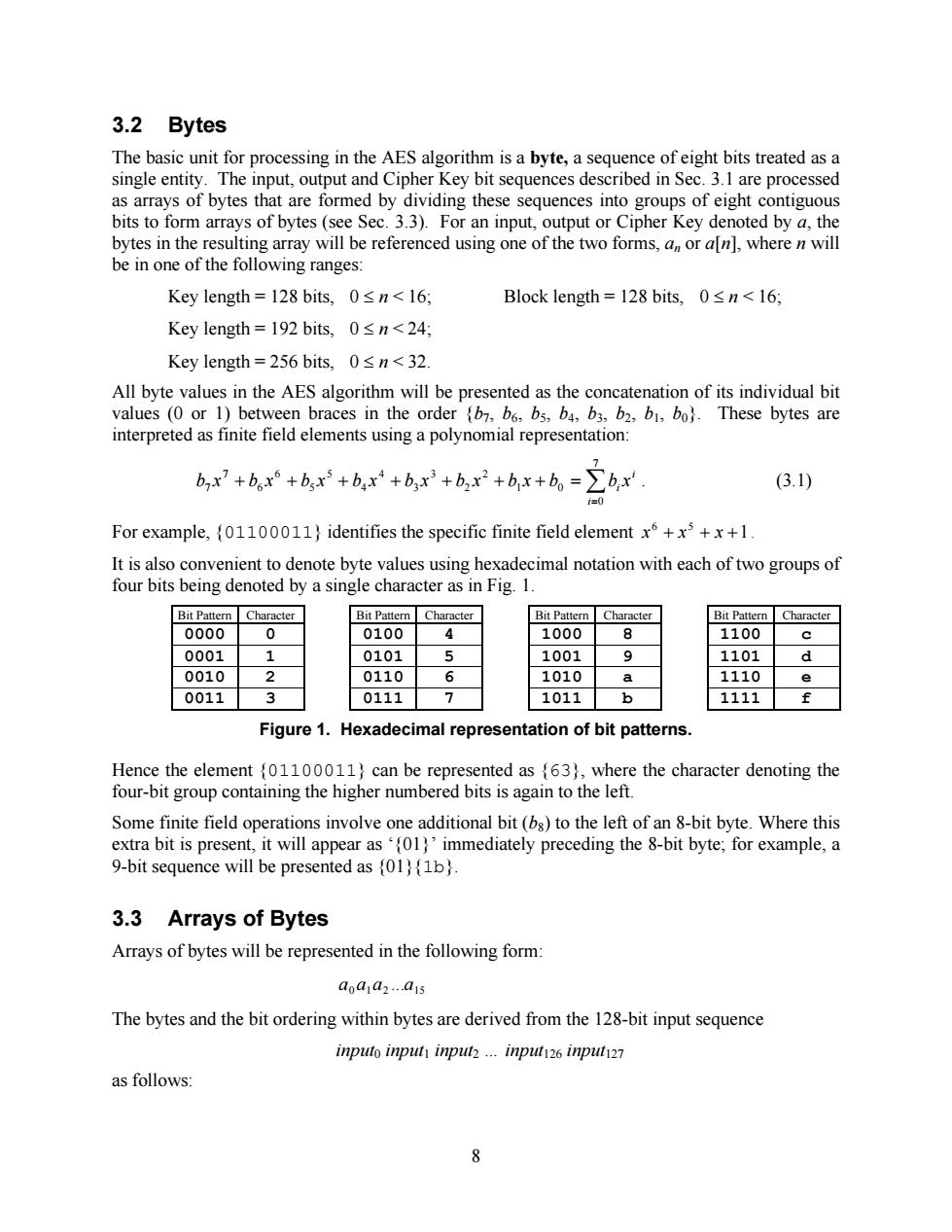正在加载图片...

3.2 Bytes The basic unit for processing in the AES algorithm is a byte,a sequence of eight bits treated as a single entity.The input,output and Cipher Key bit sequences described in Sec.3.1 are processed as arrays of bytes that are formed by dividing these sequences into groups of eight contiguous bits to form arrays of bytes(see Sec.3.3).For an input,output or Cipher Key denoted by a,the bytes in the resulting array will be referenced using one of the two forms,an or a[n],where n will be in one of the following ranges: Key length=128 bits,0sn<16; Block length=128 bits,0sn<16; Key length 192 bits,0sn<24; Key length=256 bits,0sn<32 All byte values in the AES algorithm will be presented as the concatenation of its individual bit values (0 or 1)between braces in the order (b7,b6,bs,b4,b3,b2,bi,bo).These bytes are interpreted as finite field elements using a polynomial representation: bax7+box+b5x5+bx+bx3+b2x2+bx+b0=>bx (3.1) i=0 For example,{01100011)identifies the specific finite field elementx+x+x+1 It is also convenient to denote byte values using hexadecimal notation with each of two groups of four bits being denoted by a single character as in Fig.I Bit Pattern Character Bit Pattern Character Bit Pattern Character Bit Pattern Character 0000 0 0100 4 1000 8 1100 a 0001 1 0101 5 1001 9 1101 d 0010 2 0110 6 1010 a 1110 e 0011 3 0111 7 1011 b 1111 E Figure 1.Hexadecimal representation of bit patterns. Hence the element {01100011)can be represented as {63),where the character denoting the four-bit group containing the higher numbered bits is again to the left. Some finite field operations involve one additional bit(bs)to the left of an 8-bit byte.Where this extra bit is present,it will appear as(01)'immediately preceding the 8-bit byte;for example,a 9-bit sequence will be presented as (011b). 3.3 Arrays of Bytes Arrays of bytes will be represented in the following form: a0a1a2.a15 The bytes and the bit ordering within bytes are derived from the 128-bit input sequence inputo input inpub...input6 input7 as follows: 88 3.2 Bytes The basic unit for processing in the AES algorithm is a byte, a sequence of eight bits treated as a single entity. The input, output and Cipher Key bit sequences described in Sec. 3.1 are processed as arrays of bytes that are formed by dividing these sequences into groups of eight contiguous bits to form arrays of bytes (see Sec. 3.3). For an input, output or Cipher Key denoted by a, the bytes in the resulting array will be referenced using one of the two forms, an or a[n], where n will be in one of the following ranges: Key length = 128 bits, 0 £ n < 16; Block length = 128 bits, 0 £ n < 16; Key length = 192 bits, 0 £ n < 24; Key length = 256 bits, 0 £ n < 32. All byte values in the AES algorithm will be presented as the concatenation of its individual bit values (0 or 1) between braces in the order {b7, b6, b5, b4, b3, b2, b1, b0}. These bytes are interpreted as finite field elements using a polynomial representation: å= + + + + + + + = 7 0 1 0 2 2 3 3 4 4 5 5 6 6 7 7 i i i b x b x b x b x b x b x b x b b x . (3.1) For example, {01100011} identifies the specific finite field element 1 6 5 x + x + x + . It is also convenient to denote byte values using hexadecimal notation with each of two groups of four bits being denoted by a single character as in Fig. 1. Bit Pattern Character Bit Pattern Character Bit Pattern Character Bit Pattern Character 0000 0 0100 4 1000 8 1100 c 0001 1 0101 5 1001 9 1101 d 0010 2 0110 6 1010 a 1110 e 0011 3 0111 7 1011 b 1111 f Figure 1. Hexadecimal representation of bit patterns. Hence the element {01100011} can be represented as {63}, where the character denoting the four-bit group containing the higher numbered bits is again to the left. Some finite field operations involve one additional bit (b8) to the left of an 8-bit byte. Where this extra bit is present, it will appear as ‘{01}’ immediately preceding the 8-bit byte; for example, a 9-bit sequence will be presented as {01}{1b}. 3.3 Arrays of Bytes Arrays of bytes will be represented in the following form: 0 1 2 15 a a a ...a The bytes and the bit ordering within bytes are derived from the 128-bit input sequence input0 input1 input2 … input126 input127 as follows: